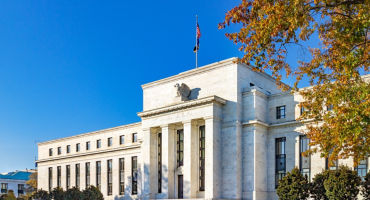- Fixed Income Analyst
Skip to main content
- Funds
- Insights
- Capabilities
- About Us
- My Account
United States, Institutional
Changechevron_rightThank you for your registration
You will shortly receive an email with your unique link to our preference center.
The views expressed are those of the author at the time of writing. Other teams may hold different views and make different investment decisions. The value of your investment may become worth more or less than at the time of original investment. While any third-party data used is considered reliable, its accuracy is not guaranteed. For professional, institutional, or accredited investors only.
The Federal Open Market Committee (FOMC) cut its target policy rate range by 50 basis points (bps) on September 18, with more than 40 bps having been priced into the market before the meeting. There was one dissenter, Fed governor Michelle Bowman, who preferred a cut of 25 bps. Fed Chair Jerome Powell stated that despite the large cut (the first of any size in four years), the FOMC believes that “the US economy is strong.”
In its statement, the FOMC characterized risks to its inflation and employment goals as “roughly in balance.” Other changes to the statement from the prior meeting seemed intended to reiterate that message. The language regarding the labor market was downgraded to say that job gains have “slowed” rather than “moderated,” and new text noted that the Fed is strongly committed to supporting maximum employment, in addition to returning inflation to target. New language also indicated that the FOMC has gained “greater confidence inflation is moving sustainably toward 2%.”
Median projections for the target range for policy rates outlined in the central bank’s Summary of Economic Projections (the “dots” on the widely watched dot plot) came down by 70 bps for both 2024 and 2025, to 4.4% and 3.4%, respectively. The longer-run dot inched up to 2.9%, but this seems more likely to be a product of material dispersion in these forecasts and changes in the FOMC’s composition, rather than a significant signal.
The Fed’s economic forecasts suggest continued growth amid a backdrop of higher unemployment and lower inflation. The median forecast for real GDP growth is 2% for the calendar years 2024 to 2027, generally little changed from June’s forecasts. However, median forecasts for the unemployment rate moved up for the next two years, while inflation forecasts fell.
Chair Powell’s tone during the press conference was best summarized by his final comment: “I don’t see anything in the economy that suggests the probability of a downturn is elevated.” He repeatedly mentioned that the large cut was intended to preserve economic strength, not respond to economic weakness. Powell largely dismissed concerns about potential acceleration in unemployment, noting that the labor market is “solid” and “close to maximum employment.” When asked about stickiness in shelter inflation, he suggested that the primary driver of housing costs is a supply imbalance, and that despite the lag, the direction of travel in shelter inflation was clearly down.
Despite the larger-than-expected rate cut, Treasury yields across the curve had moved higher by the end of Powell’s press conference, indicating that some market participants had expected the dots to forecast more cuts. Powell’s optimism may also have supported the price action, but the Fed’s stance has changed over the last few months. In July, the Fed maintained its policy rates; yesterday, it cut them more than expected. Since the June meeting, the Fed’s year-end projection for the target range declined by 70 bps, while its projection for the unemployment rate increased by 40 bps.
While the Fed’s assessment of the economy is important, they are imperfect forecasters. History suggests that the risks to the housing and labor markets are more material than Powell’s tone suggests. As always, we believe investors should focus on the data, not the Fed Chair’s read of it.
Expert

FOMC: Easing into uncertainty
Continue readingChart in Focus: Is the Fed rate cut positive for risk?
Continue readingThe Fed architecture under scrutiny: What are the investment implications?
Continue readingFOMC: Cushioning the US labor market
Continue readingTwilight zone: how to interpret today’s uncertain macro picture
Continue readingRethinking the Fed’s dual mandate
Continue readingBy
Stagflation watch: Thoughts on tariffs, inflation, and Fed policy
Continue readingURL References
Related Insights
Stay up to date with the latest market insights and our point of view.
Thank you for your registration
You will shortly receive an email with your unique link to our preference center

FOMC: Easing into uncertainty
Fixed Income Portfolio Manager Jeremy Forster profiles the Fed's December rate cut, labor market trends, inflation pressures, and the role of anticipated changes to FOMC leaders in 2026.

Chart in Focus: Is the Fed rate cut positive for risk?
In this edition of Chart in Focus, we examine how the Fed’s long-awaited interest rate cut may influence risk assets.

The Fed architecture under scrutiny: What are the investment implications?
Macro Strategist Juhi Dhawan looks at how changes in the Federal Reserve's personnel and decision making could impact policy, the US dollar, and financial markets.

FOMC: Cushioning the US labor market
Fixed Income Portfolio Manager Jeremy Forster analyzes the Fed's decision to cut interest rates at the September FOMC meeting.

Twilight zone: how to interpret today’s uncertain macro picture
Macro Strategist John Butler and Investment Director Marco Giordano explore how to interpret today’s uncertain macroeconomic picture and its key implications.

Rethinking the Fed’s dual mandate
Is it time for a fresh perspective on the dual mandate? Fixed Income Portfolio Manager Brij Khurana explores the potential benefits of reorienting monetary policy toward maximizing productivity.
By

Stagflation watch: Thoughts on tariffs, inflation, and Fed policy
US Macro Strategist Juhi Dhawan considers signs the US economy may be moving toward a toxic mix of slowing growth and rising inflation, creating challenges for the Fed and investors.

Severance: The split between the economy and the markets
While markets have bounced back since Liberation Day, policy changes and macro data bear watching. Heading into the second half of 2025, we're focused on relative opportunities across asset classes created by disconnects and divides between markets and economies.

Oh baby, baby, it’s a wild world
Just one quarter into the year, many policy and economic assumptions have been turned on their head. What does it all mean for equity, bond, and commodity markets around the world? Members of our Investment Strategy & Solutions Group offer their outlook.

Fed delivers rate cut, but hawkish 2025 guidance sends yields up
Fixed Income Analyst Caroline Casavant examines the outcome of the December 18 Federal Open Market Committee meeting and the implications for rates, inflation, and real growth.

Going their separate ways: Capitalizing on bond divergence
Our fixed income experts discuss how to position portfolios for a world of uncertainty and divergence, exploring key themes and evolving bond opportunities for 2025.
Multiple authors
URL References
Related Insights
© Copyright 2025 Wellington Management Company LLP. All rights reserved. WELLINGTON MANAGEMENT ® is a registered service mark of Wellington Group Holdings LLP. For institutional or professional investors only.
Enjoying this content?
Get similar insights delivered straight to your inbox. Simply choose what you’re interested in and we’ll bring you our best research and market perspectives.
Thank you for joining our email preference center.
You’ll soon receive an email with a link to access and update your preferences.